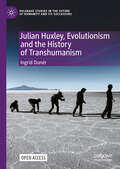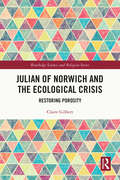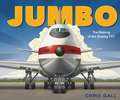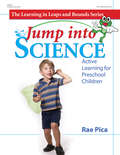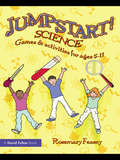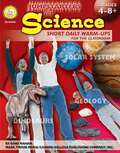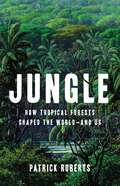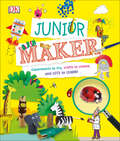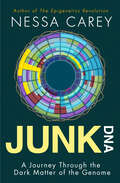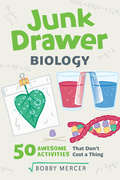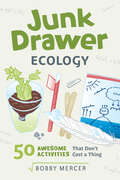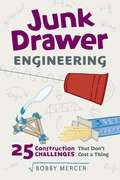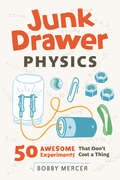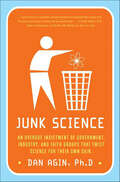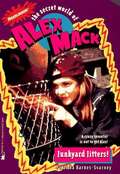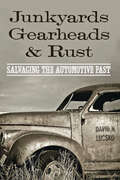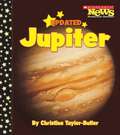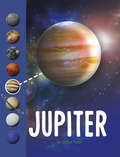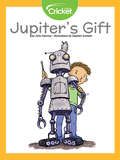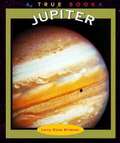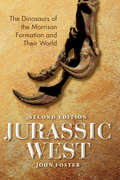- Table View
- List View
Julian Huxley, Evolutionism and the History of Transhumanism (Palgrave Studies in the Future of Humanity and its Successors)
by Ingrid DunérThe evolutionary biologist Julian Huxley (1887–1975) attempted to promote a “religion for the future,” which he would come to refer to as Transhumanism. Transhumanism was an attempt to unite a more traditional humanistic view of the human as containing some form of core essence or potential with an evolutionary point of view of humans as a work in progress. Before humans, natural selection had been responsible for the transformation of life. Through its ordering principles and through chance, it had given rise to humankind, which had ushered in a new phase of evolution. Humanity stood on the threshold of yet another critical point in evolution: The consciously purposive phase of evolution. This open access book explores the history of transhumanism by analyzing how Julian Huxley’s transhumanism develops and why it does at this particular point in time, by placing it firmly within the context of his specific scientific and sociopolitical milieu, starting roughly in the interwar years and stretching over the Second World War to the 1970s. Continuing, the study then focuses on the new transhumanists of the 1970s, 1980s and 1990s and investigates continuity in mode of thinking, contributing to a more coherent understanding of transhumanism, its history and of modern projects of human enhancement. The book captures how scientific and technological development in relation to society and social order shapes images and expectations of the future and of what future is desirable.
Julian of Norwich and the Ecological Crisis: Restoring Porosity (Routledge Science and Religion Series)
by Claire GilbertThis book presents ecological insights drawn from a reading of Julian of Norwich, considering how effectively she can help us in our current plight. The argument is that to address the ecological crisis with the mindset that created it will only cause more problems, and that to really undo the harm humanity has done and continues to do will take a transformation of selfhood and hence of perception, from the Gestell, technological self that is the child of the Enlightenment to the porous self that we truly are, underneath our buffered, separated, controlling and lonely exterior. The author suggests Julian of Norwich’s text Revelations of Divine Love has the power to effect this transformation if we can learn to read it as disciples, not masters, just as Julian received and responded to her revelations as a performative, porous, receptive disciple. The chapters describe the technological mindset and its causal relationship with the ecological crisis, and articulate in detail how, if they are to transform us, we must read the Julian texts, taking first steps away from our technological selves as we do so. The book then takes significant passages from Julian and reads them in the performative, porous way that has been recommended. It will be of particular interest to scholars of theology and ecology, as well as medieval mysticism.
Jumbo: The Making of the Boeing 747
by Chris GallFor the 50th anniversary of the Boeing 747’s first commercial flight, a picture book about the development of the iconic passenger plane and how it changed the history of air travel. In 1968, the biggest passenger jet the world had ever seen premiered in Everett, Washington. The giant plane was called the Boeing 747, but reporters named it “the Jumbo jet.” There was only one problem. It couldn’t fly. Yet.Jumbo details the story of the world’s first wide body passenger jet, which could hold more people than any other plane at the time and played a pivotal role in allowing middle class families to afford overseas travel. Author and illustrator Chris Gall, himself a licensed pilot, shows how an innovative design, hard work by countless people, and ground-breaking engineering put the Jumbo jet in the air. On January 22, 1970, the Boeing 747 made it's first transatlantic flight, taking passengers from New York to Paris in seven hours.
Jump Into Science: Active Learning for Preschool Children
by Rae PicaJump into science with 100 active learning experiences! Jump into Science is the perfect way to turn children's love of active games into learning opportunities! Bring science to life by helping children learn about their bodies, animals, seasons, and the weather. The activities in each chapter are organized by level of difficulty, and each one incorporates fun, exciting science experiences with movement. Most activities require few or no materials and include related children's books or music to extend the learning. The science skills index is an invaluable reference tool, giving teachers flexibility to plan around children's interests. Research shows that the most effective way for children to learn concepts is to experience them physically. Jump into Science offers just this kind of learning. Activities such as The Mirror Game, Dinosaur Stomp, and Water and Ice will actively engage children as they explore new science concepts!
Jumpstart! Science: Games and Activities for Ages 5-11 (Jumpstart)
by Rosemary FeaseyJumpstart! Science provides teachers with a range of lively, short, fun activities and games to support teaching and learning in different aspects of the science curriculum. It encourages teachers to develop creative approaches to motivating and engaging children in science. The activities are aimed at a number of areas of science from learning scientific words to recalling information and problem solving. This fun book helps to ‘jumpstart’: lessons plenary sessions children moving from one aspect of science or type of learning in science to another. There are more than 55 engaging science games and activities in this book to ‘jumpstart’ science lessons in every Key Stage 1 and 2 classroom. Practical, easy-to-do and highly motivating, the science ‘jumpstarts’ will appeal to busy primary teachers who wish to enliven their practice and add creativity to their science teaching.
Jumpstarters for Science: Short Daily Warm-ups for the Classroom
by Gary RahamConnect students in grades 4 and up with science using Jumpstarters for Science: Short Daily Warm-Ups for the Classroom. This 48-page resource covers matter and energy, living things, ecosystems and habitats, astronomy and space sciences, earth materials, and ancient life. The book includes five warm-ups per reproducible page, answer keys, and suggestions for use.
Jungle: How Tropical Forests Shaped the World—and Us
by Patrick Roberts"A bold, ambitious and truly wonderful history of the world"—Peter Wohlleben, author of The Hidden Life of TreesFrom the age of dinosaurs to the first human cities, a groundbreaking new history of the planet that tropical forests made. To many of us, tropical forests are the domain of movies and novels. These dense, primordial wildernesses are beautiful to picture, but irrelevant to our lives. Jungle tells a different story. Archaeologist Patrick Roberts argues that tropical forests have shaped nearly every aspect of life on earth. They made the planet habitable, enabled the rise of dinosaurs and mammals, and spread flowering plants around the globe. New evidence also shows that humans evolved in jungles, developing agriculture and infrastructure unlike anything found elsewhere. Humanity&’s fate is tied to the fate of tropical forests, and by understanding how earlier societies managed these habitats, we can learn to live more sustainably and equitably today. Blending cutting-edge research and incisive social commentary, Jungle is a bold new vision of who we are and where we come from.
Junior Maker: Experiments to Try, Crafts to Create, and Lots to Learn!
by DKArts and crafts experiments to try at home. Learn, play, and craft with this fantastic activity-packed ebook that will test and expand your creativity.This kids' arts and crafts ebook will teach and engage your little creator in 20 interactive activities, crafts, and experiments carefully designed to complement what children are learning at school. There is so much to do, and even more to learn with Junior Maker. This interactive ebook encourages hands-on play through carefully designed experiments that complement what children are taught in school. Prepare to get down, messy, and have heaps of fun while learning – perfect for kids aged 6 – 8.Specific step-by-step instructions and visuals help young readers and makers explore subjects such as space, nature, history, animals, and science. Crafting ideas appear next to excellent illustrations and photographs and fun fact informative text that is easy to read. What looks like inspirational material helps to teach children these important topics and make it exciting for them. Every fun educational experiment is based around basic household items and inexpensive and easy-to-find art supplies to keep things simple. Little creators can expect to use familiar things like buttons and marshmallows to map our solar system, make a bottle jetpack while learning about gravity, design a rain gauge to measure rainfall, and much more. Make, Do, Learn And Impress Your Friends With Fun Experiments! Have fun while learning by embarking on a journey through history, nature, and science! Make a Roman soldier's shield, experiment with a chemical reaction that blows up a balloon, or look at the stars and explore the solar system. This ebook combines fun and learning together to create a full educational experience. With Junior Maker, any child can improve their understanding of things to help them inside and out of the classroom.Whether your child is an aspiring scientist, astronaut, or is merely curious about our great big world, Junior Maker will get them thinking, learning, and making. Through fun and interactive activities, your little creator will learn about:- Space - History - Nature- Animals - ScienceThis science ebook for kids will teach your child about a given subject through interactive activities, crafts, and experiments. Further your knowledge and add to your experiments at home by advancing to our Makers Lab book series which will keep the crafting party in your lab going with more exciting science experiments and activities.
Junk DNA: A Journey Through the Dark Matter of the Genome
by Nessa CareyFor decades after the identification of the structure of DNA, scientists focused only on genes, the regions of the genome that contain codes for the production of proteins. Other regions that make up 98 percent of the human genome were dismissed as "junk," sequences that serve no purpose. But researchers have recently discovered variations and modulations in this junk DNA that are involved with a number of intractable diseases. Our increasing knowledge of junk DNA has led to innovative research and treatment approaches that may finally ameliorate some of these conditions.Junk DNA can play vital and unanticipated roles in the control of gene expression, from fine-tuning individual genes to switching off entire chromosomes. These functions have forced scientists to revisit the very meaning of the word "gene" and have engendered a spirited scientific battle over whether or not this genomic "nonsense" is the source of human biological complexity. Drawing on her experience with leading scientific investigators in Europe and North America, Nessa Carey provides a clear and compelling introduction to junk DNA and its critical involvement in phenomena as diverse as genetic diseases, viral infections, sex determination in mammals, and evolution. We are only now unlocking the secrets of junk DNA, and Nessa Carey's book is an essential resource for navigating the history and controversies of this fast-growing, hotly disputed field.
Junk DNA: A Journey Through the Dark Matter of the Genome
by Nessa CareyAn exploration of the once-ignored portion of our DNA and the role it plays in our bodies, from the author of The Epigenetics Revolution.For decades after the identification of the structure of DNA, scientists focused only on genes, the regions of the genome that contain codes to produce proteins. Other regions that make up 98 percent of the human genome were dismissed as "junk," sequences that serve no purpose. But researchers have recently discovered variations and modulations in this junk DNA that are involved with several intractable diseases. Our increasing knowledge of junk DNA has led to innovative research and treatment approaches that may finally ameliorate some of these conditions. Junk DNA can play vital and unanticipated roles in the control of gene expression, from fine-tuning individual genes to switching off entire chromosomes. These functions have forced scientists to revisit the very meaning of the word &“gene&” and have engendered a spirited scientific battle over whether or not this genomic &“nonsense&” is the source of human biological complexity. Drawing on her experience with leading scientific investigators in Europe and North America, Nessa Carey provides a clear and compelling introduction to junk DNA and its critical involvement in phenomena as diverse as genetic diseases, viral infections, sex determination in mammals, and evolution. We are only now unlocking the secrets of junk DNA, and Nessa Carey's book is an essential resource for navigating the history and controversies of this fast-growing, hotly disputed field.&“Engaging, informative, and humorous.&”—Sharon Y. R. Dent, University of Texas MD Anderson Cancer Center&“A cutting-edge, exhaustive guide to the rapidly changing, ever-more mysterious genome.&”—New Scientist
Junk Drawer Biology: 50 Awesome Experiments That Don't Cost a Thing (Junk Drawer Science)
by Bobby MercerBiology is the study of life, and all the wonderful, squishy, messy parts that living things are made of. And children love messy science, especially hands-on experimentation! Junk Drawer Biology will demonstrate that you don't need high-tech equipment to make learning fun—just what you can find in your recycling bin and around the house. Aspiring doctors can build a model of human lungs with balloons and a soda bottle, and a homemade stethoscope with tubing and plastic lid. Budding gardeners will germinate beans and explore how leaves "breathe" and "sweat." And all ages will enjoy a double helix made of candy.Science educator Bobby Mercer provides readers with hands-on experiments to explain the building blocks of living matter for children of all ages. The projects can be modified to meet the skill levels of the children doing them, from elementary school kids to teenagers. Though each challenge includes suggested materials and one step-by-step, illustrated solution, children are encouraged to think further come up with more questions to answer. Educators and parents will find this title a handy resource to teach children while having a lot of fun.
Junk Drawer Chemistry: 50 Awesome Experiments That Don't Cost a Thing
by Bobby MercerA children's instructional book on how to use readily available materials to turn the house into a science lab Science teacher Bobby Mercer provides readers with more than 50 great hands-on experiments that can be performed for just pennies, or less. Each project has a materials list, detailed step-by-step instructions with illustrations, and a brief explanation of the scientific principle being demonstrated. From turning three pennies and two galvanized washers into a simple battery to crushing a soda can using atmospheric pressure, the experiments in this book call for materials that are recycled or repurposed--crayons, plastic drink bottles, balloons, ice cubes, and other basic items found around the house. Junk Drawer Chemistry also includes sidebars of fascinating chemistry facts. Educators and parents will find this title a handy resource to teach children about chemistry topics that include atoms, compounds, solutions, mixtures, reactions, thermodynamics, acids and bases, and more, while having fun at the same time.
Junk Drawer Ecology: 50 Awesome Experiments That Don't Cost a Thing (Junk Drawer Science #7)
by Bobby MercerKids of all ages can use recycled and repurposed household items to complete exciting and green ecology experimentsJunk Drawer Ecology is a hands-on guide to saving the planet. Fun, free science activities help kids of all ages learn about the science of our planet's ecology. The environment is changing every day, and we can help slow that change. Using free or low-cost things children already have around their homes, these activities are perfect to stimulate young brains. Readers will learn about the importance of the polar regions without leaving their communities, about new ways to cut our dependence on fossil fuels, about all forms of pollution, and how they can make a difference.Junk Drawer Ecology will give inquisitive kids many hours of fun and help them learn at the same time.
Junk Drawer Engineering: 25 Construction Challenges That Don't Cost a Thing
by Bobby MercerThere's no need for expensive, high-tech materials to test your engineering skills—you probably have all you need in your home junk drawer. Each hands-on project in this book will challenge you to come up with a unique solution to a specific design problem. Construct a Pasta Bridge strong enough to support a heavy load, using only dry linguini and glue. Build a Marble Roller Coaster from recycled cardboard tubes, in which the marble "car" jumps a track to land safely at its final destination. Or design an Egg Catch device to safely capture a free-falling egg. Test yourself or use them for friendly competitions—who can come up with the best solution? These 25 open-ended design challenges can be performed for just pennies . . . or less. Each project has a suggested materials list, step-by-step instructions with illustrations for one possible solution, and suggestions on how to adapt each challenge for different ages and skill levels. Educators and parents will find this title a handy resource to teach children problem-solving skills and applied physics, all while having a lot of fun.
Junk Drawer Physics: 50 Awesome Experiments That Don't Cost a Thing
by Bobby MercerA children's instructional book on how to use readily available materials to turn the house into a science lab Physics teacher Bobby Mercer provides readers with more than 50 great hands-on experiments that can be performed for just pennies, or less. Turn a plastic cup into a pinhole camera using waxed paper, a rubber band, and a thumbtack. Build a swinging wave machine using a series of washers suspended on strings from a yardstick. Or construct your own planetarium from an empty potato chip canister, construction paper, scissors, and a pin. Each project has a materials list, detailed step-by-step instructions with illustrations, and a brief explanation of the scientific principle being demonstrated. Junk Drawer Physics also includes sidebars of fascinating physics facts, such as did you know the Eiffel Tower is six inches taller in summer than in winter because its steel structure expands in the heat? Educators and parents will find this title a handy resource to teach children about physics topics that include magnetism, electricity, force, motion, light, energy, sound, and more, and have fun at the same time.
Junk Science: An Overdue Indictment of Government, Industry, and Faith Groups that Twist Science for Their Own Gain
by Dan AginAn overdue indictment of government, industry, and faith groups that twist science for their own gain.During the next thirty years, the American public will suffer from a rampage against reason by special interests in government, commerce, and the faith industry, and the rampage has already begun. In Junk Science, Dan Agin offers a response—a stinging condemnation of the egregious and constant warping of science for ideological gain.In this provocative, wide-ranging, and hard-hitting book, Agin argues from the center that we will pay a heavy price for the follies of people who consciously twist the public's understanding of the real world.In an entertaining but frank tone, Agin separates fact from conveniently "scientific" fiction and exposes the data faking, reality ignoring, fear mongering, and outright lying that contribute to intentionally manufactured public ignorance. Many factions twist scientific data to maintain riches and power, and Agin outs them all in sections like these:--"Buyer Beware" (genetically modified foods, aging, and tobacco companies)--"Medical Follies" (chiropractics, health care, talk therapy)--"Poison and Bombs in the Greenhouse" (pollution, warfare, global warming)--"Religion, Embryos, and Cloning"--"Genes, Behavior, and Race"We already pay a heavy price for many groups' conscious manipulation of the public's understanding of science, and Junk Science arms us with understanding, cutting through the fabric of lies and setting the record straight.
Junkyard Jitters! (The Secret World of Alex Mack #11)
by Patricia Barnes-SvarneyWhen Ray asks Alex to help him with his paper route, she can hardly turn him down. What are best friends for, anyway? But tossing the news is hard work, and Alex can't resist using her powers to help out. Not that there's anyone around to see...except the eccentric old inventor who lives in the junkyard. When he catches Alex flowing like a lightning bug, she's only a little worried. But then the goons from Paradise Valley Chemical show up at the junkyard, too. Did the old man blow the whistle on her? Or is he working for the plant...on an invention to catch the GC-161 kid?
Junkyards, Gearheads, and Rust: Salvaging the Automotive Past
by David N. LucskoThe material appeal of the automobile junkyard goes beyond the search for second-hand parts.What happens to automobiles after they are retired but before they are processed as scrap? In this fascinating history, David N. Lucsko takes readers on a tour of salvage yards and wrecked or otherwise out-of-service cars in the United States from the point of view of gearheads—the hot rodders, restoration hobbyists, street rodders, and classic car devotees who reuse, repurpose, and restore junked cars.Junkyards, Gearheads, and Rust is a nuanced exploration of the business of dismantling wrecks and selling second-hand parts. It examines the reinterpretation of these cars and parts by artists as well as their restoration by enthusiasts. It also surveys the origin and evolution of gearhead-oriented yards that specialize in specific types of automobiles; dissects the material and emotional appeal of the salvage yard and its contents among enthusiasts; and examines how zoning and nuisance ordinances have affected both salvage businesses and hobbyists. Lucsko concludes with an analysis of efforts during the last twenty-five years to hasten vehicular obsolescence at the expense of salvage yards, mechanics, and enthusiasts. By examining how cars are salvaged, repurposed, and restored, this book demonstrates that the history of the automobile is much more than a running catalog of showroom novelties.
Jupiter
by Christine Taylor-ButlerFeatures: - Includes vocabulary word hunt with pronunciations, glossary, and index - Labeled diagrams and timelines - Beautiful, full-color photographs - Simple interior design and easy-to-read fonts - Web sites for further research and information - Vocabulary preview and review pages plus backmatter pages that invite readers to think further on the study topics - Fits science curriculum standards for earth & space science and science and technology What's New: - Updated illustrations and photos - Updated art of solar system shows 8 planets and their orbits instead of 9 - New Pluto book includes a list of other dwarf planets, in addition to Pluto, in our solar system - Updated information on space missions, moons, and planets - Updated Web sites for further information in backmatter - Updated indexes
Jupiter (Planet Guides)
by Duncan BrewerThis short but informative book gives many fascinating facts about the Planet Jupiter. The book outlines the planet's history and scientific discovers about it through the ages. It talks about the planets place in mythology, as well as what NASA has discovered about its composition. Contains a glossary of terms, recommended books to read, and some very fascinating facts about its many moons. Worth reading for anyone interested in the planet Jupiter.
Jupiter (Planets in Our Solar System)
by Steve FoxeEverything about Jupiter is big! Its size is big. Even its storms are big! Get the big and small facts about this gas giant that can be seen glowing in the night sky.
Jupiter's Gift
by John SamonyTim is working on his science fair project—a robot! When he spends a weekend afternoon with his great-uncle, he learns that his love of engineering and technology runs in the family. After Great-Uncle Bate lends him a little creativity to help figure out what’s wrong with the robot, Tim learns an awesome secret about him!
Jupiter, Ceres and the Asteroids (World Book's Solar System and Space Exploration Library)
by Dan Blunk"Introduction to Jupiter, Ceres, and the Asteroids, providing to primary and intermediate grade students information on their features and exploration. Includes fun facts, glossary, resource list and index"--Provided by publisher.
Jupiter: A True Book
by Larry Dane BrimnerDescribes the appearance, climate, moons, and exploration of the largest planet in the solar system.
Jurassic West, Second Edition: The Dinosaurs of the Morrison Formation and Their World (Life of the Past)
by John FosterThe famous bone beds of the Morrison Formation, formed one hundred and fifty million years ago and running from Wyoming down through the red rock region of the American Southwest, have yielded one of the most complete pictures of any ancient vertebrate ecosystem in the world. Jurassic West, Second Edition tells the story of the life of this ancient world as scientists have so far been able to reconstruct it.Aimed at the general reader, Jurassic West, Second Edition recounts the discovery of many important Late Jurassic dinosaurs such as Apatosaurus, Allosaurus, and Stegosaurus. But dinosaurs compose barely a third of the more than 90 types of vertebrates known from the formation, which include crocodiles and turtles, frogs and salamanders, dinosaurs and mammals, clams and snails, and ginkgoes, ferns, and conifers.Featuring nearly all new illustrations, the second edition of this classic work includes new taxa named since 2007, updates to the naming and classifications of some old taxa, and expanded sections on numerous aspects of Morrison Formation paleontology and geology.
